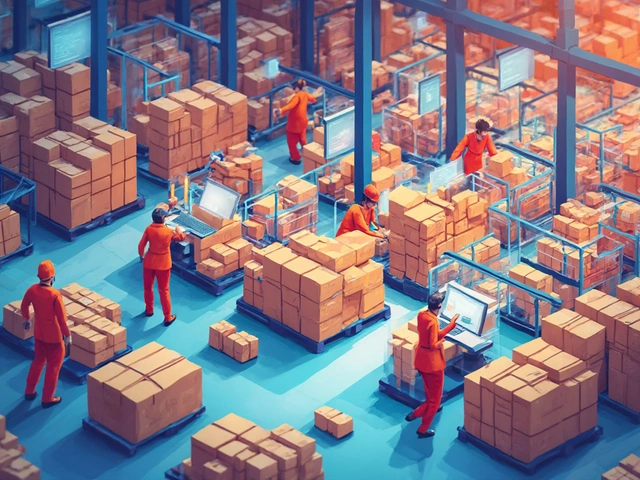You check your tracking, and there it is: "Package received by courier." Those four words can spark relief, confusion, or even a hint of impatience. After all, you paid for delivery, and now the only thing standing between you and that much-awaited parcel is… well, what exactly? What actually happens when a courier marks your package as received? Believe it or not, this status is more than just a checkpoint in a delivery maze—it's a turning point in your parcel's journey.
So, What Does 'Package Received By Courier' Really Mean?
You’d think that a shipping status would be pretty self-explanatory, but “Package received by courier” hides more behind those words than you might guess. Basically, it means the courier—think FedEx, UPS, DHL, Royal Mail, or whoever's handling your goods—has physically picked up your package. It's not lounging at a warehouse anymore. It’s not in the seller’s back room. Someone from the delivery company has actually put their hands on your package and scanned it into their own system. This handoff is huge. Why? Temporary chaos in shipping centers means a package can’t start moving through the delivery network until the courier claims responsibility. Only then do all the magic updates (those tracking pings we constantly refresh) start rolling in.
But here's where people get tripped up: "Package received by courier" doesn't mean your item is zipping straight towards your door. It means the courier now owns the next steps. You’d be surprised by the adventures your stuff might have—sorting facilities, loading docks, even spending a night in a regional warehouse. Each move gets logged in the system, and each scan brings new updates to your tracking page. For example, Amazon and DHL both rely on strict hand-scanning rules to ensure every package gets its moment in the spotlight. Packages aren’t just dropped in anonymous bins—they’re barcoded, scanned, and entered into company records. Every big courier does this, all to keep that chain of custody rock-solid. As one logistics manager at FedEx once told the Wall Street Journal,
"Tracking accuracy hinges on that first scan—if the handoff isn’t logged, the whole system risks breaking down."
And while some smaller couriers might batch a bunch of packages before logging the group, big-name companies almost never skip that first status update. This explains why sometimes you place an order, get a 'ready to ship' notification, but don't see progress for a day or two. The seller may have pre-created shipping labels but hasn’t physically handed the package over. Only when you see 'package received by courier' do things really get moving. And remember, weekends, holidays, and even bad weather can slow down these initial handoffs.
What Happens Behind the Scenes After a Courier Receives Your Package?
Packages entering the courier’s possession launch into a whirlwind series of processes that most people don’t even know exist. First, the barcode you see on the outside of your parcel is scanned and checked against digital manifests. If you’re shipping something with tracking, that scan is your package’s ticket to ride. But it doesn’t just leap onto a delivery truck. Instead, the item often travels through local distribution centers, getting sorted with possibly thousands of others. Each courier company has its own way of moving things, but the basic idea is the same: keep packages flowing and avoid piles of undelivered stuff.
In busy shipping seasons—think Black Friday or Christmas—a single sorting hub might handle hundreds of thousands of packages a night. Automated systems with conveyor belts and robotic arms do most of the heavy lifting, scanning and moving items at breakneck speed. Yet, while it sounds super-high tech, humans are still in the mix, manually resolving barcodes that won’t scan or packages that don’t fit the conveyor. If you wonder whether all this fancy tech makes a difference, it absolutely does: a 2023 UPS report showed that advanced scanning and sorting cut average transit times by 18% compared to 2017. But, even with all this progress, errors happen, and mislabeled or jammed packages might take a detour, pausing your delivery progress temporarily.
Location matters too. If your package gets picked up from a major city, it may spend less time bouncing between facilities than if it starts from a small town or rural warehouse. Packages heading internationally will get routed to export sorting centers—adding customs checks and paperwork to the journey. For ecommerce, the transition to the courier’s hands is the moment sellers breathe easier. Beforehand, any goof is on them. After that scan, any lost package isn’t their headache anymore. That’s why most online stores will tell you your order has shipped only once it’s in the courier’s control, not just when the label’s printed.
Common Problems and How to Handle Package Tracking Uncertainty
Nothing triggers a nervous refresh-fest quite like tracking info stuck on “package received by courier.” People often get anxious when this status lingers. Maybe it doesn’t update for a day, or worse, several. Sometimes, there’s a legitimate holdup in the sorting process (like a snowstorm shutting down a facility), but other times, it’s just a matter of the next scan not being logged quickly. About 7% of tracked packages in major Western countries will have status delays of at least one full business day—so you’re not alone if you’re checking your phone every hour.
What should you do if you see a standstill? First, breathe. Tracking systems update in batches, especially late at night or early morning. Give it a full day before panicking. Next, look for clues from your courier. Most offer alerts for delays, weather issues, or misroutes that could slow down your delivery. If several days pass with zero changes, it’s okay to drill deeper. Contact your courier directly—have your tracking number handy. Sometimes, support staff can see more detailed logs on their systems than you can online.
If you bought through a big retailer or marketplace, check their help center. Most have refund or replacement programs if your item disappears in transit. Keep in mind that “package received by courier” puts a chunk of responsibility on the courier’s shoulders—so any compensation or insurance claim would need details from this handoff point onward. Shipping insurance can be a smart add-on if you’re sending something valuable. And don’t forget to double-check the delivery address and details when ordering; one typo can mean a package spends extra days bouncing around courier depots.
- Give at least 24 hours for tracking to update after seeing "package received by courier"
- Sign up for courier text/email alerts for real-time updates
- Contact support if tracking doesn’t budge after 72 hours
- If the package is time-sensitive or expensive, consider adding shipping insurance
- Always verify your address before completing an online purchase
Tips for Smoother Shipping and Keeping Tabs on Your Package
You’ve probably noticed that some deliveries seem to move at light speed, while others crawl along at a snail’s pace. There are plenty of practical little tricks to make sure your shipments avoid common snags and get to you as quickly as possible. First, accuracy is everything: double-checking the postal code, apartment number, and your own contact info means one less excuse for delays. Using a verified delivery address also speeds up sorting. For regular shippers, setting up a user profile with your preferred courier allows you to view all your deliveries in one place and even reroute packages if you're out when the courier arrives.
Big cities offer parcel lockers or pickup centers, a lifesaver if you can’t be home all day for a delivery. For those who live in apartments, putting clear instructions like a call or text before delivery helps prevent the old “delivery attempted” horror when you were home the whole time. If your area is known for package theft, consider using signature-required shipping or a friend’s business address for deliveries. There are also independent apps—like AfterShip and ParcelTrack—that consolidate tracking from major courier companies, sending alerts the second any status changes, even if you ordered from multiple different websites.
Smart packers also don’t skimp on labeling. Clear, scannable barcodes, and a waterproof sleeve for paperwork make a world of difference if weather turns nasty. You might even want to snap a photo of your parcel—if shipping insurance is involved, this can make claims much simpler. Some couriers, like FedEx and UPS, now offer live map tracking on delivery day, showing you exactly where the truck is in your neighborhood. Not every service has this yet, but adoption is growing each year. When you finally see "out for delivery," you’re close, but until you get that status, it’s still all about the scans and route planning happening in the background.
When it comes to understanding shipping updates, keep this in mind: package received by courier signals the real start of your package’s journey through the delivery network. The rest is just about staying patient, watching those tracking pings, and keeping communication lines with your courier open. Get savvy about your tracking options, double-check those details, and—if in doubt—don’t hesitate to ask the courier for a status check. It’s remarkable how much smooth shipping really comes down to getting the basics right, trusting the process, and knowing just what those status updates are actually saying about your precious parcel’s latest adventure.




